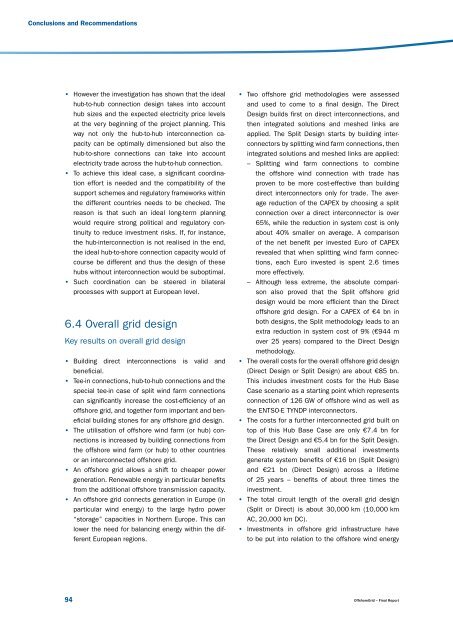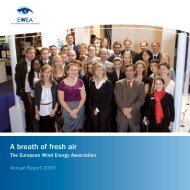Offshore Electricity Infrastructure in Europe - European Wind Energy ...
Offshore Electricity Infrastructure in Europe - European Wind Energy ...
Offshore Electricity Infrastructure in Europe - European Wind Energy ...
Create successful ePaper yourself
Turn your PDF publications into a flip-book with our unique Google optimized e-Paper software.
conclusions and recommendations<br />
• However the <strong>in</strong>vestigation has shown that the ideal<br />
hub-to-hub connection design takes <strong>in</strong>to account<br />
hub sizes and the expected electricity price levels<br />
at the very beg<strong>in</strong>n<strong>in</strong>g of the project plann<strong>in</strong>g. This<br />
way not only the hub-to-hub <strong>in</strong>terconnection capacity<br />
can be optimally dimensioned but also the<br />
hub-to-shore connections can take <strong>in</strong>to account<br />
electricity trade across the hub-to-hub connection.<br />
• To achieve this ideal case, a significant coord<strong>in</strong>ation<br />
effort is needed and the compatibility of the<br />
support schemes and regulatory frameworks with<strong>in</strong><br />
the different countries needs to be checked. The<br />
reason is that such an ideal long-term plann<strong>in</strong>g<br />
would require strong political and regulatory cont<strong>in</strong>uity<br />
to reduce <strong>in</strong>vestment risks. If, for <strong>in</strong>stance,<br />
the hub-<strong>in</strong>terconnection is not realised <strong>in</strong> the end,<br />
the ideal hub-to-shore connection capacity would of<br />
course be different and thus the design of these<br />
hubs without <strong>in</strong>terconnection would be suboptimal.<br />
• Such coord<strong>in</strong>ation can be steered <strong>in</strong> bilateral<br />
processes with support at <strong>Europe</strong>an level.<br />
6.4 Overall grid design<br />
Key results on overall grid design<br />
• Build<strong>in</strong>g direct <strong>in</strong>terconnections is valid and<br />
beneficial.<br />
• Tee-<strong>in</strong> connections, hub-to-hub connections and the<br />
special tee-<strong>in</strong> case of split w<strong>in</strong>d farm connections<br />
can significantly <strong>in</strong>crease the cost-efficiency of an<br />
offshore grid, and together form important and beneficial<br />
build<strong>in</strong>g stones for any offshore grid design.<br />
• The utilisation of offshore w<strong>in</strong>d farm (or hub) connections<br />
is <strong>in</strong>creased by build<strong>in</strong>g connections from<br />
the offshore w<strong>in</strong>d farm (or hub) to other countries<br />
or an <strong>in</strong>terconnected offshore grid.<br />
• An offshore grid allows a shift to cheaper power<br />
generation. Renewable energy <strong>in</strong> particular benefits<br />
from the additional offshore transmission capacity.<br />
• An offshore grid connects generation <strong>in</strong> <strong>Europe</strong> (<strong>in</strong><br />
particular w<strong>in</strong>d energy) to the large hydro power<br />
“storage” capacities <strong>in</strong> Northern <strong>Europe</strong>. This can<br />
lower the need for balanc<strong>in</strong>g energy with<strong>in</strong> the different<br />
<strong>Europe</strong>an regions.<br />
• Two offshore grid methodologies were assessed<br />
and used to come to a f<strong>in</strong>al design. The Direct<br />
Design builds first on direct <strong>in</strong>terconnections, and<br />
then <strong>in</strong>tegrated solutions and meshed l<strong>in</strong>ks are<br />
applied. The Split Design starts by build<strong>in</strong>g <strong>in</strong>terconnectors<br />
by splitt<strong>in</strong>g w<strong>in</strong>d farm connections, then<br />
<strong>in</strong>tegrated solutions and meshed l<strong>in</strong>ks are applied:<br />
– Splitt<strong>in</strong>g w<strong>in</strong>d farm connections to comb<strong>in</strong>e<br />
the offshore w<strong>in</strong>d connection with trade has<br />
proven to be more cost-effective than build<strong>in</strong>g<br />
direct <strong>in</strong>terconnectors only for trade. The average<br />
reduction of the CAPEX by choos<strong>in</strong>g a split<br />
connection over a direct <strong>in</strong>terconnector is over<br />
65%, while the reduction <strong>in</strong> system cost is only<br />
about 40% smaller on average. A comparison<br />
of the net benefit per <strong>in</strong>vested Euro of CAPEX<br />
revealed that when splitt<strong>in</strong>g w<strong>in</strong>d farm connections,<br />
each Euro <strong>in</strong>vested is spent 2.6 times<br />
more effectively.<br />
– Although less extreme, the absolute comparison<br />
also proved that the Split offshore grid<br />
design would be more efficient than the Direct<br />
offshore grid design. For a CAPEX of €4 bn <strong>in</strong><br />
both designs, the Split methodology leads to an<br />
extra reduction <strong>in</strong> system cost of 9% (€944 m<br />
over 25 years) compared to the Direct Design<br />
methodology.<br />
• The overall costs for the overall offshore grid design<br />
(Direct Design or Split Design) are about €85 bn.<br />
This <strong>in</strong>cludes <strong>in</strong>vestment costs for the Hub Base<br />
Case scenario as a start<strong>in</strong>g po<strong>in</strong>t which represents<br />
connection of 126 GW of offshore w<strong>in</strong>d as well as<br />
the ENTSO-E TYNDP <strong>in</strong>terconnectors.<br />
• The costs for a further <strong>in</strong>terconnected grid built on<br />
top of this Hub Base Case are only €7.4 bn for<br />
the Direct Design and €5.4 bn for the Split Design.<br />
These relatively small additional <strong>in</strong>vestments<br />
generate system benefits of €16 bn (Split Design)<br />
and €21 bn (Direct Design) across a lifetime<br />
of 25 years – benefits of about three times the<br />
<strong>in</strong>vestment.<br />
• The total circuit length of the overall grid design<br />
(Split or Direct) is about 30,000 km (10,000 km<br />
AC, 20,000 km DC).<br />
• Investments <strong>in</strong> offshore grid <strong>in</strong>frastructure have<br />
to be put <strong>in</strong>to relation to the offshore w<strong>in</strong>d energy<br />
94 <strong>Offshore</strong>Grid – F<strong>in</strong>al Report









